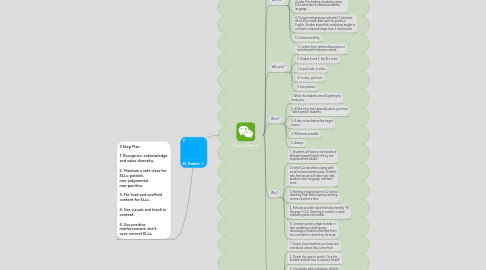
1. Thai and Chinese
1.1. Who?
1.1.1. The teacher
1.2. What?
1.2.1. 1. Acknowledge the differences between countries, but show respect and regard for their country.
1.2.2. 2. Don't apply Western academic expectations on Thai students immediately. Make your expectations clear, but give them time to adapt.
1.2.3. 3. Break down content into manageable chunks. Pre-loading vocabulary gives ELLs extra time to absorb academic language.
1.2.4. 4. Pictures and gestures activate L1 schemae, which ELLs must draw upon to produce English. Studies show that vocabulary taught in context is retained longer than if memorized.
1.2.5. 5. Correct carefully.
1.3. Where?
1.3.1. 1. Contact time; before discussions or activities with relevant content.
1.3.2. 2. Grades 4 and 5, the ELL room.
1.3.3. 3. In pull-outs, in class.
1.3.4. 4. In class, pull-outs.
1.3.5. 5. Everywhere.
1.4. When?
1.4.1. 1. While the students are still getting to know you.
1.4.2. 2. All the time, but especially when you have "silent period" students.
1.4.3. 3. A day or two before the target lesson.
1.4.4. 4. Whenever possible.
1.4.5. 5. Always.
1.5. Why?
1.5.1. 1. Students will have a more positive attitude toward English if they feel respected and valued.
1.5.2. 2. Early ELLs are often coping with social and emotional issues. Children who feel secure will take more risks, produce more language, and learn more.
1.5.3. 3. Starting a large project in L2 can be daunting. Help them cope by working on one chunk at a time.
1.5.4. 4. Pictures provide clues that help mentally "fill the gaps" in L2. Teaching in context is more interesting and memorable.
1.5.5. 5. Correcting every single mistake in their speaking or writing may discourage a student and make them less confident in what they do know.
1.6. How?
1.6.1. 1. Simply show students you know and care about where they come from.
1.6.2. 2 . Resist the urge to punish. Give the student another way to express herself.
1.6.3. 3. Coordinate with colleagues, identify key vocabulary and concepts for pre-teaching.
1.6.4. 4. Draw charts and pictures on whiteboard; use flashcards, posters and student art, online images and videos. Seek out authentic, grade-level reading material.
1.6.5. 5. Praise good work, but never condemn, discourage, or express doubt in your ELLs.

